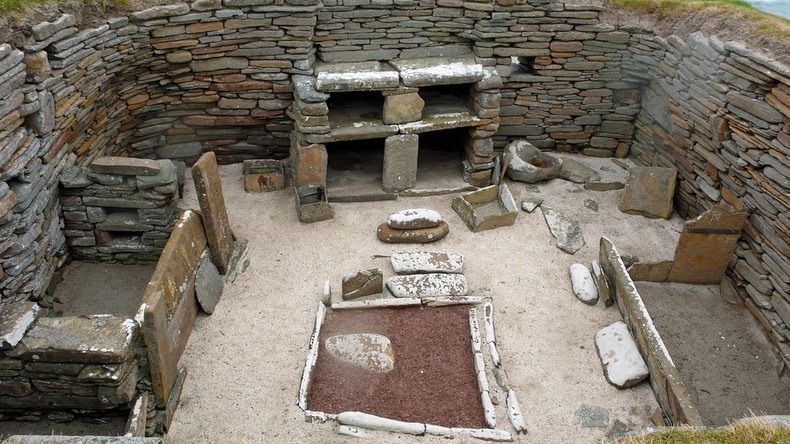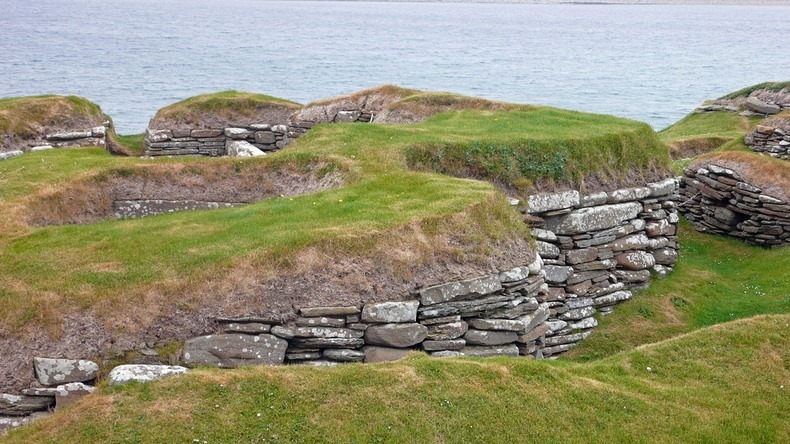Skara Brae, on the Bay of Skaill, in the Orkney Isles to the north-east of mainland Scotland, was a late Neolithic settlement consisting of eight stone houses that were inhabited between 3,200 and 2,500 BC. This ancient settlement is the best preserved Neolithic village in northern Europe. Not only are the walls of the structures still standing, and alleyways roofed with their original stone slabs, but the interior fittings of each house give an unparalleled glimpse into the lives of the farmers who lived there more than 5,000 years ago.
Skara Brae’s discovery was an accident. In 1850 a violent storm ravaged the Bay of Skaill revealing an outline of a village consisting of a number of small houses without roofs that was buried beneath the sand dunes. The local laird began an amateur excavation of the site, but after uncovering four houses the work was abandoned in 1868. The site remained undisturbed until 1913, when during a single weekend the site was plundered by a party with shovels who took away an unknown quantity of artifacts. In 1924 when another storm swept away part of one of the houses, it was determined the site should be made secure and more seriously investigated. The first proper excavation of Skara Brae was done in 1927.
Skara Brae's remarkable survival through the ages is thanks to the design of the original builders who buried the stone-slab walls up to roof level in clay soil and waste material in order to provide insulation and protection from the elements. The houses can be entered through a small doorway which would have been blocked by a slab of stone and possibly barred as well. Seven of the houses shares the same basic design - a large square room, with a central fireplace, a bed on either side and a shelved dresser on the wall opposite the doorway. One of the beds is larger than the other and it is suggested that the larger bed could have belonged to the male and the smaller one to the female. An equally convincing argument could be made that the women and children occupied the large beds and that the men slept on their own in the smaller ones.
Ample storage space was provided by a number of cupboards built into the walls. Between the hearth and the dresser there was often a stone block. Near the dresser were rectangular stone boxes sunk into the floor. The corners were lined with clay to make them waterproof. A sophisticated drainage system was even incorporated into the village's design, one that included a primitive form of toilet in each dwelling.
The eight house sits all by itself on the west side of the village, and has a distinct appearance. This house has none of the usual furnishings—no beds, no limpet boxes and no dresser. Instead, there is much more storage space and an additional room. When this house was excavated, fragments of stone, bone and antler were found. It is possible that this building was used as a house to make simple tools such as bone needles or flint axes. The presence of heat-damaged volcanic rocks and what appears to be a flue, support this interpretation.
The village at Skara Brae was occupied for at least 600 years before it was finally abandoned sometime around the middle of the third millennium BC. Over the centuries that followed the sea steadily encroached on the site until it was finally buried beneath its protective layer of sand. Today Skara Brae is rightly considered one of the world's great archaeological treasures and has been carefully preserved by Historic Scotland.
In 1999 Skara Brae were designated as a UNESCO World Heritage site.


Sources: Wikipedia, BBC, OdysseyAdventures
























Whoa! That is so cool! I love old stuff like this-thanks for sharing this gem!
ReplyDelete